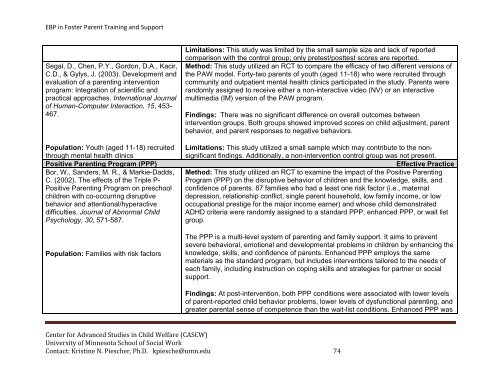Evidence-Based Practice in Foster Parent Training and Support ...
Evidence-Based Practice in Foster Parent Training and Support ...
Evidence-Based Practice in Foster Parent Training and Support ...
Create successful ePaper yourself
Turn your PDF publications into a flip-book with our unique Google optimized e-Paper software.
EBP <strong>in</strong> <strong>Foster</strong> <strong>Parent</strong> Tra<strong>in</strong><strong>in</strong>g <strong>and</strong> <strong>Support</strong>Segal, D., Chen, P.Y., Gordon, D.A., Kacir,C.D., & Gylys, J. (2003). Development <strong>and</strong>evaluation of a parent<strong>in</strong>g <strong>in</strong>terventionprogram: Integration of scientific <strong>and</strong>practical approaches. International Journalof Human-Computer Interaction, 15, 453-467.Limitations: This study was limited by the small sample size <strong>and</strong> lack of reportedcomparison with the control group; only pretest/posttest scores are reported.Method: This study utilized an RCT to compare the efficacy of two different versions ofthe PAW model. Forty-two parents of youth (aged 11-18) who were recruited throughcommunity <strong>and</strong> outpatient mental health cl<strong>in</strong>ics participated <strong>in</strong> the study. <strong>Parent</strong>s werer<strong>and</strong>omly assigned to receive either a non-<strong>in</strong>teractive video (NV) or an <strong>in</strong>teractivemultimedia (IM) version of the PAW program.F<strong>in</strong>d<strong>in</strong>gs: There was no significant difference on overall outcomes between<strong>in</strong>tervention groups. Both groups showed improved scores on child adjustment, parentbehavior, <strong>and</strong> parent responses to negative behaviors.Population: Youth (aged 11-18) recruitedthrough mental health cl<strong>in</strong>icsLimitations: This study utilized a small sample which may contribute to the nonsignificantf<strong>in</strong>d<strong>in</strong>gs. Additionally, a non-<strong>in</strong>tervention control group was not present.Positive <strong>Parent</strong><strong>in</strong>g Program (PPP) Effective <strong>Practice</strong>Bor, W., S<strong>and</strong>ers, M. R., & Markie-Dadds, Method: This study utilized an RCT to exam<strong>in</strong>e the impact of the Positive <strong>Parent</strong><strong>in</strong>gC. (2002). The effects of the Triple P- Program (PPP) on the disruptive behavior of children <strong>and</strong> the knowledge, skills, <strong>and</strong>Positive <strong>Parent</strong><strong>in</strong>g Program on preschool confidence of parents. 87 families who had a least one risk factor (i.e., maternalchildren with co-occurr<strong>in</strong>g disruptive depression, relationship conflict, s<strong>in</strong>gle parent household, low family <strong>in</strong>come, or lowbehavior <strong>and</strong> attentional/hyperactive occupational prestige for the major <strong>in</strong>come earner) <strong>and</strong> whose child demonstrateddifficulties. Journal of Abnormal Child ADHD criteria were r<strong>and</strong>omly assigned to a st<strong>and</strong>ard PPP, enhanced PPP, or wait listPsychology, 30, 571-587.group.Population: Families with risk factorsThe PPP is a multi-level system of parent<strong>in</strong>g <strong>and</strong> family support. It aims to preventsevere behavioral, emotional <strong>and</strong> developmental problems <strong>in</strong> children by enhanc<strong>in</strong>g theknowledge, skills, <strong>and</strong> confidence of parents. Enhanced PPP employs the samematerials as the st<strong>and</strong>ard program, but <strong>in</strong>cludes <strong>in</strong>terventions tailored to the needs ofeach family, <strong>in</strong>clud<strong>in</strong>g <strong>in</strong>struction on cop<strong>in</strong>g skills <strong>and</strong> strategies for partner or socialsupport.F<strong>in</strong>d<strong>in</strong>gs: At post-<strong>in</strong>tervention, both PPP conditions were associated with lower levelsof parent-reported child behavior problems, lower levels of dysfunctional parent<strong>in</strong>g, <strong>and</strong>greater parental sense of competence than the wait-list conditions. Enhanced PPP wasCenter for Advanced Studies <strong>in</strong> Child Welfare (CASCW)University of M<strong>in</strong>nesota School of Social WorkContact: Krist<strong>in</strong>e N. Piescher, Ph.D. kpiesche@umn.edu 74
















